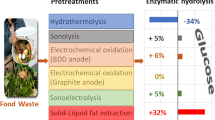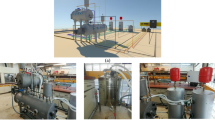Abstract
Household food waste (HFW) a complex biomass containing soluble sugars, lipids, proteins, cellulose, was used for bioethanol production at high substrate concentration and low enzyme loadings. HFW was subjected to microwave digestion (121 °C, 15 min) at 20 % (w/v) substrate concentration in the presence or absence of dilute sulfuric acid. The whole slurry was hydrolyzed and simultaneously saccharified and fermented using 5 and 10 FPU/g dry HFW. Enzymatic hydrolysis resulted in glucose yields in the range of 44–47 % of the theoretical (based on potential glucose content in the HFW) for both enzyme loadings tested, indicating that enzyme loadings lower than 10 FPU/g HFW could be used. During SSF tests the highest ethanol production (23.12 g/L) was obtained from the pretreated in the presence of dilute sulfuric acid HFW at 10 FPU/g HFW. In an attempt to protect the soluble fraction from possible decomposition and increase ethanol concentration, hot water treatment and higher substrate concentrations were examined. At optimal pretreatment conditions (100 °C, 60 min), glucose yields of 54.69 and 58.39 % (of the theoretical based on potential glucose content in the HFW) were achieved at 30 and 50 % w/v substrate concentration, respectively, which corresponds to an ethanol production of 17.44 and 31.03 g/L, respectively. In order to overcome the technical difficulties due to high initial viscosity of the material, when operating hydrolysis and fermentation at high initial substrate concentrations, a non-isothermal simultaneous saccharification and fermentation process operating in fed-batch mode was applied at 40 % (w/v) final substrate concentration, resulting in 42.66 g/L (or 107 g/kg HFW) ethanol production.




Similar content being viewed by others
References
Balat, M.: Production of bioethanol from lignocellulosic materials via the biochemical pathway: a review. Energy Convers. Manag. 52, 858–875 (2011)
European Commission: Green paper—on the management of bio-waste in the European Union. Brussels (Belgium), 3 December 2008 (COM(2008) 811 final)
Lin, C.S.K., Pfaltzgraff, L.A., Herrero-Davila, L., Mubofu, E.B., Abderrahim, S., Clark, J.H., Koutinas, A.A., Kopsahelis, N., Stamatelatou, K., Dickson, F., Thankappan, S., Mohamed, Z., Brocklesby, R., Luque, R.: Food waste as a valuable resource for the production of chemicals, materials and fuels. Current situation and global perspective. Energy Environ. Sci. 6, 426–464 (2013)
Hong, Y.S., Yoon, H.H.: Ethanol production from food residues. Biomass Bioenergy 35, 3271–3275 (2011)
Commission, European: Directive 2003/30/EC of the European parliament and of the council of 8 May 2003 on the promotion of the use of biofuels or other renewable fuels for transport. Off. J. Eur. Union L. 123, 42–46 (2003)
Kim, J.H., Lee, J.C., Pak, D.: Feasibility of producing ethanol from food waste. Waste Manag 31, 2121–2125 (2011)
Hahn-Hägerdal, B., Gable, M., Gorwa-Grauslund, M.F., Lidén, G., Zacchi, G.: Bio-ethanol—the fuel of tomorrow from the residues of today. Trends Biotechnol. 24(12), 549–556 (2006)
Olofsson, K., Bertilsson, M., Lidén, G.: A short review on SSF—an interesting process option for ethanol production from lignocellulosic feedstocks. Biotechnol. Biofuels 1, 7 (2008). doi:10.1186/1754-6834-1-7
Fan, Z.L., Lynd, L.R.: Conversion of paper sludge to ethanol. I: impact of feeding frequency and mixing energy characterization. Bioproc. Biosyst. Eng. 30, 27–34 (2007)
Hoyer, K., Galbe, M., Zacchi, G.: Effects of enzyme feeding strategy on ethanol yield in fed-batch simultaneous saccharification and fermentation of spruce at high dry matter. Biotechnol. Biofuels 3, 14 (2010). doi:10.1186/1754-6834-3-14
Sotiropoulos, A., Malamis, D., Loizidou, M.: Pilot scale demonstration of food waste drying at household level. In: VENICE2012 Fourth International Symposium on Energy from Biomass and Waste, San Servolo, Venice, Italy, 12–15 November 2012
Ghose, T.K.: Measurement of cellulase activities. Pure Appl. Chem. 59(2), 257–268 (1987)
AOAC: Official Methods of Analysis of the Association of Official Analytical Chemists, 15th edn. AOAC Inc, USA (1990)
Phatak, L., Chang, K.C., Brown, G.: Isolation and characterization of pectin in sugar-beet pulp. J. Food Sci. 53, 830–833 (1988)
Sluiter, A., Hames, B., Ruiz, R., Scarlata, C., Sluiter, J., Templeton, D., Crocker, D.: Determination of structural carbohydrates and lignin in biomass. Technical report NREL/TP-510-42618 (2012)
Vázquez, M., Oliva, M., Téllez-Luis, S.J., Ramírez, J.A.: Hydrolysis of sorghum straw using phosphoric acid: evaluation of furfural production. Bioresour. Technol. 98, 3053–3060 (2007)
Miller, G.L.: Use of dinitrosalisylic acid reagent for determination of reducing sugars. Anal. Chem. 31, 426–428 (1959)
Wyman, C.E.: What is (and is not) vital to advancing cellulosic ethanol. Trends Biotechnol. 25(4), 153–157 (2007)
Kumar, R., Wyman, C.E.: Effect of enzyme supplementation at moderate cellulase loadings on initial glucose and xylose release from corn stover solids pretreated by leading technologies. Biotechnol. Bioeng. 102, 457–467 (2009)
Dogaris, I., Gkounda, O., Mamma, D., Kekos, D.: Bioconversion of dilute-acid pretreated sorghum bagasse to ethanol by Neurospora crassa. Appl. Microbiol. Biotechnol. 95, 541–550 (2012)
Ballesteros, M., Sáez, F., Ballesteros, I., Manzanares, P., Negro, M.J., Martínez, J.M., Castañeda, R., Dominguez, J.M.O.: Ethanol production from the organic fraction obtained after thermal pretreatment of municipal solid waste. Appl. Biochem. Biotechnol. 161, 423–431 (2010)
Li, K., Zhang, K., Andresen, J.M.: Production of fermentable sugars from enzymatic hydrolysis of pretreated municipal solid waste after autoclave process. Fuel 92, 84–88 (2012)
Zheng, Y., Pan, Z., Zhang, R., Labavitch, J.M., Wang, D., Teter, S.A., Jenkins, B.M.: Evaluation of different biomass materials as feedstock for fermentable sugar production. Appl. Biochem. Biotechnol. 136–140, 423–435 (2007)
Li, A., Antizar-Ladislao, B., Khraisheh, M.: Bioconversion of municipal solid waste to glucose for bio-ethanol production. Bioproc. Biosyst. Eng. 30, 189–196 (2007)
Sassner, P., Galbe, M., Zacchi, G.: Techno-economic evaluation of bioethanol production from three different lignocellulosic materials. Biomass Bioenergy 32, 422–430 (2008)
Jørgensen, H., Kristensen, J.B., Felby, C.: Enzymatic conversion of lignocellulose into fermentable sugars: challenges and opportunities. Biofuels Bioprod. Biorefining 1, 119–134 (2007)
Wu, A., Lee, Y.Y.: Nonisothermal simultaneous saccharification and fermentation for direct conversion of lignocellulosic biomass to ethanol. Appl. Biochem. Biotechol. 70–72, 1109–1117 (1988)
Varga, E., Klinke, H.B., Réczey, K., Thomsen, A.B.: High solid simultaneous saccharification and fermentation of wet oxidized corn stover to ethanol. Biotechnol. Bioeng. 88(5), 567–574 (2004)
Walker, K., Vadlani, P., Madl, R., Ugorowski, P., Hohn, K.L.: Ethanol fermentation from food processing waste. Environ. Prog. Sustain. Energy (2012). doi:10.1002/ep.11700
Cekmecelioglu, D., Uncu, O.N.: Kinetic modeling of enzymatic hydrolysis of pretreated kitchen wastes for enhancing bioethanol production. Waste Manag 33, 735–739 (2013)
Man, H.L., Beher, S.K., Park, H.S.: Optimization of operational parameters for ethanol production from Korean food waste leachate. Int. J. Environ. Sci. Technol. 7, 157–164 (2010)
Moon, H.C., Song, I.S., Kim, J.C., Shirai, Y., Lee, D.H., Kim, J.K., Chung, S.O., Kim, D.H., Oh, K.K., Cho, Y.S.: Enzymatic hydrolysis of food waste and ethanol fermentation. Int. J. Energy Res. 33, 164–172 (2009)
Tang, Y.-Q., Koike, Y., Liu, K., An, M.-Z., Morimura, S., Wu, X.-L., Kida, K.: Ethanol production from kitchen waste using the flocculating yeast Saccharomyces cerevisiae strain KF-7. Biomass Bioenergy 32, 1037–1045 (2008)
Yan, S., Chen, X., Wu, J., Wang, P., Ye, J., Yao, J.: Enzymatical hydrolysis of food waste and ethanol production from the hydrolysate. Renew. Energy 36, 1259–1265 (2011)
Yan, S., Wang, P., Zhai, Z., Yao, J.: Fuel ethanol production from concentrated food waste hydrolysates in immobilized cell reactors by Saccharomyces cerevisiae H058. J. Chem. Technol. Biotechnol. 86, 731–738 (2010)
Yan, S., Chen, X., Wu, J., Wang, P.: Ethanol production from concentrated food waste hydrolysates with yeast cells immobilized on corn stalk. Appl. Microbiol. Biotechnol. 94, 829–838 (2012)
Wang, Q., Ma, H., Xu, W., Gong, L., Zhang, W., Zou, D.: Ethanol production from kitchen garbage using response surface methodology. Biochem. Eng. J. 39, 604–610 (2008)
Koike, Y., An, M.-Z., Tang, Y.-Q., Syo, T., Osaka, N., Morimura, S., Kida, K.: Production of fuel ethanol and methane from garbage by high-efficiency two-stage fermentation process. J. Biosci. Bioeng. 108(6), 508–512 (2009)
Lissens, G., Klinke, H., Verstraete, W., Ahring, B., Thomsen, A.B.: Wet oxidation treatment of organic household waste enriched with wheat straw for simultaneous saccharification and fermentation into ethanol. Environ. Technol. 25, 647–655 (2004)
Acknowledgments
This work is based on the research that was carried out in the framework of a LIFE + project entitled: «Development and demonstration of an innovative method of converting waste into bioethanol» Waste2Bio, (LIFE 11 ENV/GR/000949, 2012–2015), which is co-financed by the European Commission. The authors would like to thank Novozymes Corporation for generously providing the cellulase enzyme samples.
Author information
Authors and Affiliations
Corresponding author
Rights and permissions
About this article
Cite this article
Alamanou, D.G., Malamis, D., Mamma, D. et al. Bioethanol from Dried Household Food Waste Applying Non-isothermal Simultaneous Saccharification and Fermentation at High Substrate Concentration. Waste Biomass Valor 6, 353–361 (2015). https://doi.org/10.1007/s12649-015-9355-6
Received:
Accepted:
Published:
Issue Date:
DOI: https://doi.org/10.1007/s12649-015-9355-6




